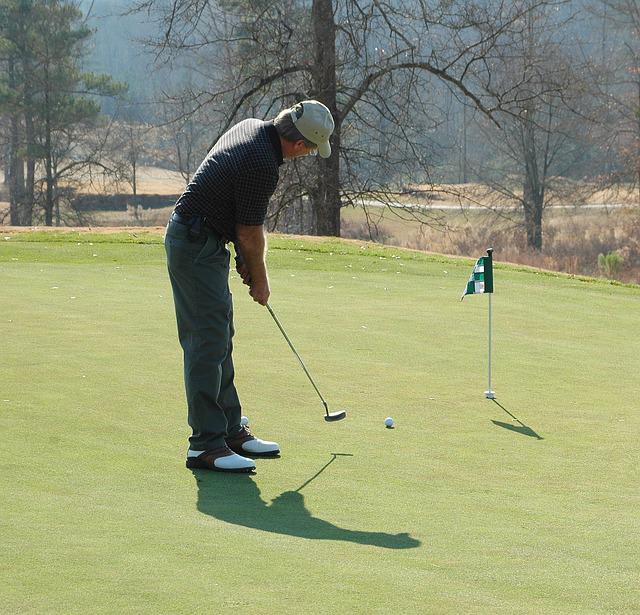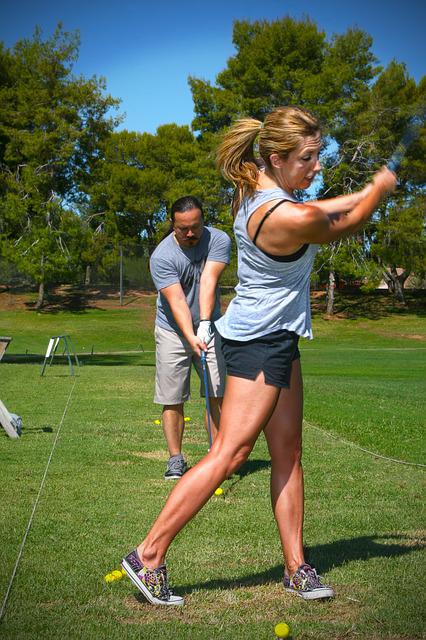How to Play Golf For Beginners
Why Golf Is a Great Sport to Learn
How to play golf for beginners the easy way. Golf is a great sport to learn for several reasons. Firstly, it is a low-impact activity that can be enjoyed by people of all ages and fitness levels. Unlike other sports that require intense physical exertion, golf allows players to set their own pace and level of intensity. This makes it an ideal sport for beginners or those looking for a more relaxed form of exercise.
Secondly, golf provides numerous health benefits. Walking the course helps to improve cardiovascular health and burn calories. Additionally, swinging the club engages various muscle groups, including the core, arms, and legs, promoting strength and flexibility. Regular play also enhances mental well-being as players are required to focus on strategy and execution while enjoying the peaceful outdoor setting.
Golf is a social sport that encourages bonding with friends, family members or colleagues. It offers an opportunity to spend quality time together in a relaxed environment while engaging in friendly competition. Golf courses often provide comfortable settings such as clubhouses where players can socialize after their round of golf. Thus, learning golf not only fosters personal growth but also facilitates meaningful connections with others who share similar interests.
Understanding the Basics of Golf

When it comes to understanding the basics of golf, there are a few key aspects that beginners should keep in mind. First and foremost, grasping the concept of the swing is crucial. The golf swing consists of a series of movements that require coordination and proper technique. It involves using various clubs to hit the ball with different levels of force and precision.
Additionally, beginners should familiarize themselves with the rules and etiquette of golf. Understanding the rules is essential for maintaining fairness during play, while adhering to proper etiquette ensures a respectful and enjoyable experience for all players on the course. This includes being mindful of pace of play, repairing divots, raking bunkers, and keeping noise levels to a minimum.
Moreover, learning about different types of golf shots can greatly enhance one’s game. From drives to approach shots and putts, each shot requires specific techniques and strategies. Taking time to practice these shots can help beginners develop their skills and improve their overall performance on the course. Ultimately, understanding these basic elements will lay a solid foundation for anyone looking to embark on their golf journey.
Essential Equipment for Beginners
When it comes to learning how to play golf, having the right equipment is essential for beginners. The first and most important piece of equipment is a set of golf clubs. It’s best to start with a basic set that includes a driver, irons, and putter. As a beginner, you don’t need to invest in expensive clubs right away; instead, focus on getting comfortable with the game before upgrading your equipment.
Another crucial piece of equipment for beginners is a golf bag. This will not only help you carry your clubs but also keep them organized and protected during transport. Look for a lightweight yet durable bag that has enough compartments for all your clubs as well as additional storage space for balls, tees, and other accessories.
Lastly, don’t forget about golf balls! As a beginner, you may lose quite a few while practicing or playing on the course. It’s recommended to purchase an affordable pack of golf balls specifically designed for beginners or those with slower swing speeds. These balls offer more forgiveness and distance than professional-grade ones.
Having the right equipment can make all the difference when starting out in golf. By investing in a suitable set of clubs, a reliable golf bag, and quality balls designed for beginners, you’ll be well-prepared to enjoy this wonderful sport while improving your skills along the way.
Mastering the Fundamentals of the Swing

Mastering the fundamentals of the swing is crucial for beginners who are looking to improve their golf game. One key aspect to focus on is the grip. The grip determines how the clubface will contact the ball, so having a proper grip can greatly affect accuracy and power. Beginners should learn to hold the club in their fingers rather than their palms, ensuring a light but secure grip.
Another fundamental element is the stance. A solid and balanced stance provides a strong foundation for a successful swing. Beginners should start by positioning their feet shoulder-width apart, with slight bending at the knees. The weight distribution between both feet should be even, allowing for stability during the swing.
Additionally, beginners must pay attention to their posture throughout the swing. Good posture ensures that players maintain balance and have better control over their shots. It involves keeping a straight back while slightly bending forward from the hips, maintaining a relaxed but engaged position throughout each shot.
By focusing on these fundamental aspects of the swing – grip, stance, and posture – beginner golfers can lay a solid foundation for improving their skills on the course and working towards becoming more proficient players in this challenging sport.
Navigating the Golf Course
When it comes to navigating the golf course, beginners may feel overwhelmed by the vastness and complexity of the layout. One important aspect to keep in mind is understanding the course’s layout and features. Familiarize yourself with each hole, noting any hazards such as bunkers, water bodies, or out-of-bounds areas that you need to avoid. Additionally, pay attention to the placement of trees and slopes that can affect your shot trajectory.
Another crucial element in navigating the golf course is strategizing your game plan. Evaluate each hole before teeing off and determine your target area for landing your shots. Take into account factors like wind direction, elevation changes, doglegs, and narrow fairways when deciding whether to play aggressively or conservatively. It’s essential to develop a strategic approach that suits your skill level while considering potential risks and rewards.
Lastly, maintaining proper etiquette on the golf course is vital for a smooth navigation experience. Be aware of other players’ positions on adjacent holes before hitting a shot; wait until they are out of range before proceeding. Repairing divots on fairways and ball marks on greens also contributes to good etiquette by keeping the course in pristine condition for others to enjoy. By being respectful towards fellow players and taking care of nature around you as well as yourself will ensure an enjoyable round while navigating through every hole of the golf course.
Tips for Improving Your Game
1. Work on your swing technique: One of the most important aspects of improving your golf game is to focus on your swing technique. This involves getting the correct grip, maintaining a smooth and even tempo throughout your swing, and practicing proper body rotation. You can seek guidance from a professional golf instructor or watch instructional videos online to help you understand and implement these techniques.
2. Practice regularly: Like any other sport or skill, practice is key when it comes to improving your golf game. Set aside dedicated time each week to hit the driving range or play a round of golf. Consistent practice will help you develop muscle memory, improve your shot accuracy, and enhance overall performance on the course.
3. Utilize mental strategies: Golf is not just about physical capabilities; it also requires mental strength and focus. Adopting mental strategies such as visualization techniques, positive self-talk, and managing emotions can significantly impact your game. Visualize successful shots before taking them, use affirmations to boost confidence, and learn how to stay calm under pressure for better decision-making on the course.
Remember that improving at golf takes time and patience. By implementing these tips into your practice routine consistently, you will gradually see progress in both your skills and enjoyment of the game!
Start Enjoying the Game of Golf
It is time to start enjoying the game of golf. Now that you have learned the basics of how to play golf as a beginner, it is important to remember that ultimately, golf is meant to be fun and enjoyable. While it may take time and practice to improve your skills on the course, don’t forget to appreciate the beauty of the sport and the opportunity it provides for relaxation and enjoyment.
One way to enhance your experience of playing golf is by finding a group of fellow players who share your passion for the game. Joining a local golf club or participating in community events can help you connect with like-minded individuals who can offer guidance and support along your journey. Not only will this give you a chance to socialize and make new friends, but it will also create a sense of camaraderie as you all work towards improving your skills together.
Lastly, always remember that even professional golfers make mistakes on the course. Instead of dwelling on every bad shot or missed opportunity, try adopting a positive mindset and focus on having fun instead. Golf offers endless opportunities for personal growth, challenge, and satisfaction – so embrace each round as an opportunity to enjoy yourself while honing your skills in this fantastic sport.
Golf is a sport that combines physical prowess, mental acuity, and a touch of finesse. While it may seem daunting to beginners, the game offers a rewarding experience as you navigate the lush greens and strive to improve your skills with each swing. Whether you’re a complete novice or have only dabbled in golf occasionally, this comprehensive guide will walk you through the essential aspects of how to play golf and help you lay the foundation for a rewarding journey in this elegant sport.
Understanding the Basics
a. Golf Equipment:
- Golf Clubs: Golf clubs are the primary tools in the game. A standard golf set includes a driver, woods, irons, wedges, and a putter. Each club has its specific purpose, and as a beginner, it’s essential to focus on mastering a few versatile clubs first. Start with a driver, a 7-iron, and a putter.
- Golf Balls: Golf balls come in various designs, catering to different skill levels. As a beginner, opt for a ball that offers distance and control without compromising on feel. Avoid premium balls initially, as they are more expensive and can be easily lost on the course.
- Golf Bag: This is where you carry your clubs. Choose a bag that suits your needs and is comfortable to carry around the course. Consider a stand bag, as it allows you to easily set it down and access your clubs during play.
b. Golf Course:
- A golf course consists of 18 holes, each varying in length and difficulty. The objective is to complete each hole in as few strokes as possible, with the total score adding up for the entire round. Courses are usually categorized by their difficulty level, from beginner-friendly to championship courses.
- The course will have different areas, such as fairways, roughs, bunkers, and the green. Understanding each area’s purpose and challenges is essential to playing successfully. For instance, fairways are well-maintained grassy areas that lead to the green, while roughs are longer grass areas surrounding the fairway, making shots more challenging.
Basic Golf Swing Mechanics
a. Grip:
- The grip is how you hold the club, and it significantly influences your shot’s accuracy and power. The most common grips are the overlapping grip (Vardon grip) and the interlocking grip. The overlapping grip involves positioning the pinky finger of your trailing hand over the index finger of your lead hand. The interlocking grip involves interlocking the pinky finger of your trailing hand with the index finger of your lead hand. Experiment with both and choose the one that feels most comfortable for you.
b. Stance:
- Your stance involves the positioning of your feet, shoulders, and hips. Aim for a stable and balanced stance, with your feet shoulder-width apart and your knees slightly bent. Your non-dominant foot should be slightly ahead of the ball. Align your feet and shoulders parallel to the target line to ensure proper alignment.
c. Posture:
- Maintain a relaxed posture with a slight bend at your hips and your spine straight. Keep your arms extended and your eyes on the ball. Your weight should be evenly distributed between your feet.
d. Backswing:
- The backswing involves taking the club back from the ball in preparation for the swing. Rotate your shoulders and hips to create torque and potential energy for the downswing. Keep your lead arm (left arm for right-handed players) straight and your wrists firm but not tense.
e. Downswing:
- The downswing is the motion of bringing the club back down to strike the ball. Focus on maintaining a smooth and controlled movement, transferring your weight from back foot to front foot as you swing through the ball. Your hips should rotate towards the target, and your wrists should release naturally through the impact zone.
f. Follow-through:
- After striking the ball, allow the club to follow through with the swing’s natural motion. Keep your body balanced and facing the target. A full and balanced follow-through indicates a well-executed swing.
Golf Etiquette and Rules
a. Golf Etiquette:
- Golf has a set of unwritten rules and customs that ensure the game’s integrity and enjoyment for all players. Respecting these etiquettes demonstrates good sportsmanship and enhances the golfing experience for everyone. Some essential etiquette tips include:
- Maintaining silence during a player’s shot to avoid distractions.
- Repairing divots and ball marks on the green to keep the course in good condition.
- Keeping pace with the group ahead to avoid slow play.
b. Basic Rules:
- Familiarize yourself with the basic rules of golf to ensure fair play and avoid unnecessary penalties. Some fundamental rules include:
- Out-of-bounds: If your ball goes beyond the course boundaries, you’ll incur a penalty stroke and must take a drop from where the ball went out-of-bounds.
- Penalty strokes: Various situations, such as hitting the ball into water hazards or losing it, may result in penalty strokes.
- Unplayable lies: If your ball lands in an unfavorable position, you have options to declare the ball unplayable and take a penalty stroke.
Getting Started on the Course
a. Practice at the Driving Range:
- Before heading out to the course, spend time at the driving range to hone your swing and get a feel for your clubs. Focus on consistency and control, rather than distance, during your initial practice sessions. Use alignment aids, such as alignment sticks, to ensure your setup and swing path are correct.
b. Start with Par-3 Courses:
- As a beginner, consider starting with par-3 courses, which are shorter and less challenging than standard 18-hole courses. This will allow you to build confidence and get comfortable with the game’s basic mechanics. Par-3 courses typically have shorter holes that require only irons and wedges, making it less intimidating for newcomers.
c. Play with Experienced Golfers:
- Playing with experienced golfers can provide valuable insights and tips. It also exposes you to different playing styles and strategies that can enhance your learning process. Don’t hesitate to ask questions and seek advice during the round.
Developing a Practice Routine
a. Consistency is Key:
- To improve your golf skills, practice regularly. Even short practice sessions a few times a week can yield better results than occasional, lengthy sessions. Consistency is essential for ingraining muscle memory and developing a reliable swing.
b. Work on Different Aspects:
- Your practice routine should encompass various aspects of the game, such as driving, approach shots, chipping, and putting. Allocate time to each aspect and focus on improving one skill at a time. Consider using training aids, such as alignment sticks, putting mats, and chipping nets, to target specific areas of improvement.
c. Record Your Progress:
- Keep track of your scores, strengths, and weaknesses during each round. This will help you identify areas that require improvement and track your progress over time. Additionally, take note of the clubs and shots that work well for you, so you can make better decisions on the course.
Seek Professional Instruction
a. Golf Lessons:
- Investing in professional golf lessons can accelerate your learning process and help you avoid developing bad habits. A qualified instructor can provide personalized guidance and tailored tips to suit your playing style.


